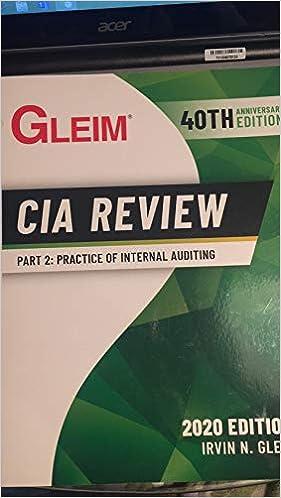Question
The Shirt Shop had the following transactions for T-shirts for 2016, its first year of operations: Jan. 20 Purchased 460 units @ $8 = $
| The Shirt Shop had the following transactions for T-shirts for 2016, its first year of operations: |
|
|
|
|
|
| ||
| Jan. 20 | Purchased | 460 units @ $8 | = | $ | 3,680 |
|
| Apr. 21 | Purchased | 260 units @ $10 | = |
| 2,600 |
|
| July 25 | Purchased | 340 units @ $13 | = |
| 4,420 |
|
| Sept. 19 | Purchased | 150 units @ $15 | = |
| 2,250 |
|
| During the year, The Shirt Shop sold 990 T-shirts for $24 each. |
| Required |
| a. | Compute the amount of ending inventory The Shirt Shop would report on the balance sheet, assuming the following cost flow assumptions: (1) FIFO, (2) LIFO, and (3) weighted average. (Round cost per unit to 2 decimal places and final answers to the nearest whole dollar amount.) | ||||||||||
|
|
| ||||||||||
|
| |||||||||||
|
| ||||||||||
| b. | Record the above transactions in general journal form and post to T-accounts using (1) FIFO, (2) LIFO, and (3) weighted average. Use a separate set of journal entries and T-accounts for each method. Assume all transactions are cash transactions. (If no entry is required for a transaction/event, select "No journal entry required" in the first account field.) |
event 1: record the entry for purchase of inventory for cash on January 20
event 2: record the entry for purchase of inventory for cash on april 21
event 3: record the entry for purchase of inventory for cash on july 25
event 4: record the entry for purchase of inventory for cash on September 19
FIFO Sales and Cost of goods sold
Event 1: record the sale of inventory for cash
Event 2: Record entry for cost of goods sold
LIFO Sales and Cost of goods sold
Event 1: Record sale of inventory for cash
Event 2: Record entry for cost of goods sold
Weighted average Sales and Cost of goods sold
Event 1: record the sale of inventory for cash
Event 2: Record entry for cost of goods sold
| 1. | FIFO | ||||||||||||||||||||||||||||||||||||||||||||||||||||||||||||||||||||||||||||||||||||||||||||||||||||||||||||||||||||||||||||||||
|
| |||||||||||||||||||||||||||||||||||||||||||||||||||||||||||||||||||||||||||||||||||||||||||||||||||||||||||||||||||||||||||||||||
|
| ||||||||||||||||||||||||||||||||||||||||||||||||||||||||||||||||||||||||||||||||||||||||||||||||||||||||||||||||||||||||||||||||
2. LIFO
|
| |||||||||||||||||||||||||||||||||||||||||||||||||||||||||||||||||||||||||||||||||||||||||||||||||||||||||||||||||||||||||||||||
| |||||||||||||||||||||||||||||||||||||||||||||||||||||||||||||||||||||||||||||||||||||||||||||||||||||||||||||||||||||||||||||||
3.Weighted Average
|
| |||||||||||||||||||||||||||||||||||||||||||||||||||||||||||||||||||||||||||||||||||||||||||||||||||||||||||||||||||||||||||||||
| |||||||||||||||||||||||||||||||||||||||||||||||||||||||||||||||||||||||||||||||||||||||||||||||||||||||||||||||||||||||||||||||
| c. | Compute the difference in gross margin between the FIFO and LIFO cost flow assumptions. |
|
| |||
|
Step by Step Solution
There are 3 Steps involved in it
Step: 1

Get Instant Access to Expert-Tailored Solutions
See step-by-step solutions with expert insights and AI powered tools for academic success
Step: 2

Step: 3

Ace Your Homework with AI
Get the answers you need in no time with our AI-driven, step-by-step assistance
Get Started


